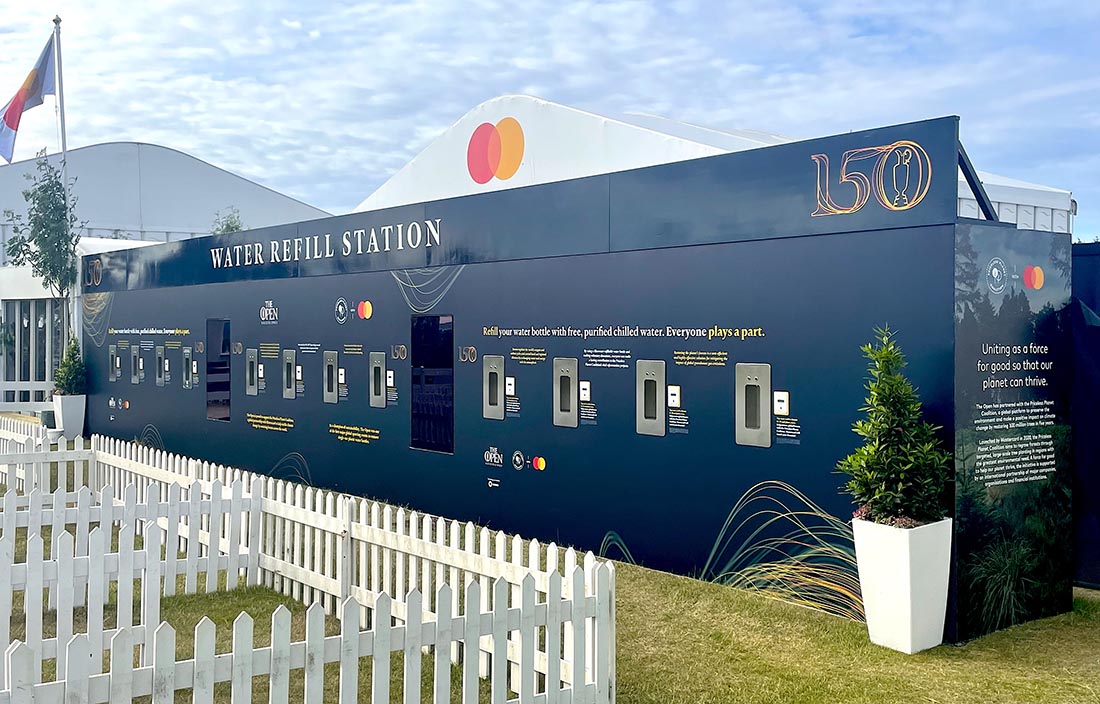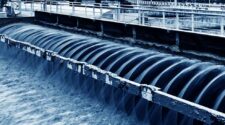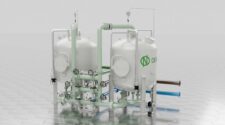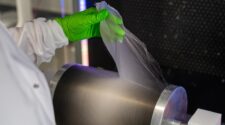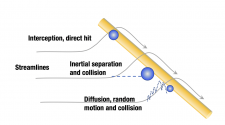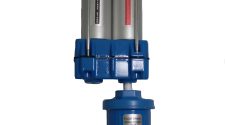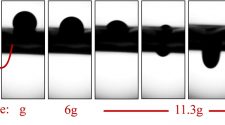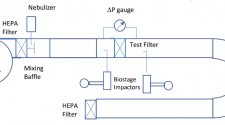Bluewater’s water purifier technology helps eliminate the need for plastic bottles
At the 150th Open Championship held in St. Andrews in Scotland this July, some 290,000 golf fans were introduced to the Wall of Water – the world’s largest water station, to date.
Measuring 16 meters in length, the station housed 12 in-line water dispensers as well as two 55-inch outdoor television screens broadcasting key content. Supported by 18 additional individual hydration stations sited at strategic locations around the venue, the Wall of Water was designed and installed by Stockholm-headquartered Bluewater, a company on a mission to end the need for single-use plastic bottles and the developer of patented SuperiorOsmosis filtration technology.
Alternatives
Over the past 40 years or so, consumers have increasingly looked for alternatives to drinking tap water that is perceived to be either unsafe or tastes bad.
Today’s traditional water treatment systems often use parameters established many years ago, based on conditions and knowledge available at that time, but today there are a host of new chemicals, pharmaceuticals and other contaminants that municipal water treatment systems in many areas of the industrialized and developing world were not designed to eradicate.
These can include toxins such as pesticides and insecticides which are leeched into water environments despite the best efforts of the agricultural industry, which uses over 70% of all the fresh water on the planet. Meanwhile, according to the World Health Organization some 1.6 million people die every year from diarrhea-related diseases caused by drinking unsafe water and lack of basic sanitation, giving free reign to hazardous microbes and bacteria.
This is far from being a problem limited to developing countries – back in 2009 a New York Times investigation revealed that more than 20% of water treatment systems violated key provisions of the U.S. Safe Drinking Water Act and a later probe of in the water of U.S. households by the Associated Press National Investigative Team found a vast array of pharmaceuticals including antibiotics, anticonvulsants, mood stabilizers and sex hormones – which potentially impacted at least 41 million Americans.
It is no surprise then, that there is a level of mistrust when it comes to tap water, and the alternatives are either bottled water or domestic filtration systems that extract contaminants from tap water.
Bottled Water
In the United States alone, sales of bottled water hit a record level of 15.7 billion gallons in 2021 according to the latest data from the Beverage Marketing Corporation (BMC) based in Wintersville, Ohio, with the average American drinking 136 liters of bottled water annually.
Beverage bottles based on PET (polyethylene terephthalate) can be very efficiently recycled – either back into bottles or PET fibers – yet according to NAPCOR, the Charlotte-based trade association for the PET packaging industry in North America, bottle collection rates have actually fallen in recent years and currently stand at around 34% of the 50 billion bottles sold in the USA annually.
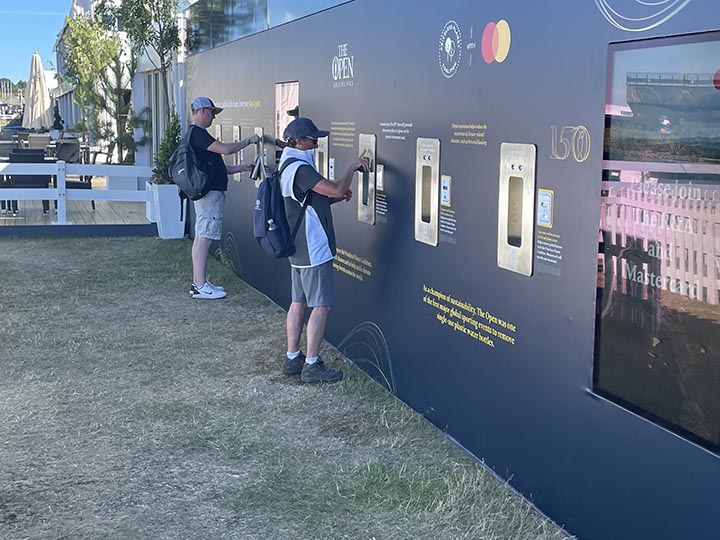
Microplastics
In addition, questions are increasingly being raised about the potential health risks posed by microplastics from PET bottles.
A recent study in France, for example, found microplastics in 78% of the bottled water it tested, while a Dutch study found PET microplastics in the blood of three-quarters of the humans it tested. Scientists at the San Giovanni Calibita Fatebenefratelli Hospital in Italy have even discovered microplastics in the placenta of unborn babies.
“These findings are horrifying, not least because we still do not know enough yet about the consequences posed to human health by the chemicals in the plastic,” said Bluewater founder and CEO Bengt Rittri.
Filter options
Many options exist for treating drinking water at home or in commercial operations, including point-of-use (POU), treating water at a single tap, or point-of-entry (POE), treating water throughout a house.
Both employ a variety of technologies to remove contaminants, including filtration, ion exchange, reverse osmosis and distillation. Depending on the system, prices can range from the relatively
affordable to thousands of dollars.
Generally speaking, carbon filters absorb organic contaminants in water that impact taste and odor, as well as removing chlorination byproducts, some cleaning solvents, pesticides and metals.
Ion exchange filters, which need to be regenerated with salt periodically, will help soften water by removing minerals such as calcium and magnesium and may tackle radium, lead and fluoride.
Distillation units create distilled water, removing the likes of nitrates, toxic metals and bacteria. Reverse osmosis cleans water of a diverse list of contaminants, including nitrates, organic compounds, foul tastes, smells and pesticides, dioxins, toxic metals and petrochemicals.
Direct flow
Reverse osmosis is considered the most effective method of purifying water due to the filtration processes that remove virtually all pollutants including micro-organisms, pesticides, heavy metals and toxins.
The technology purifies water by forcing untreated water through a series of semi-permeable filters and membranes which block chemical, and other contaminants as well as bad odors and tastes. The filter captures everything nasty down to 0.0001 micron.
Traditionally, however, a drawback to reverse osmosis filters is that they frequently use more water to flush away the contamination filtered out than they provide for drinking.
Bluewater’s SuperiorOsmosis, however, wastes 80% less water than competing solutions and also ensures on-demand direct flow straight from the water mains.

PFAS
Independently-verified research by Bluewater has also proven the efficiency of its water purifier technology at removing up to 99.99% of health threatening microplastics and chemicals such as toxic PFAS (per-and polyfluoroalkyl substances) from tap water.
Two studies were instigated at the Royal Institute of Technology (KTH) in Sweden. The first study involved heavily contaminating drinking water with four common microplastic particles – PE, PP, PS, and PVC – prior to feeding it into an under-sink Bluewater PRO purifier, with conclusive results. A second study proved a Bluewater PRO will also successfully remove 99.99% of the four most common PFAS compounds in drinking water listed by the Swedish National Food Agency – PFOA, PFOS, PFBA, and PFBS. The Bluewater findings were independently verified by Eurofins.
In June, the U.S. Environmental Protection Agency warned that PFAS chemicals are more toxic than earlier thought and it is planning aggressive action to prevent them from entering the environment.
PFAS are widely used in thousands of products and have been linked to serious health problems such as cancer, birth defects, decreased immunity and reproductive problems. In Europe, a number of countries have already announced efforts to restrict the manufacturing, marketing and use of PFAS.
FloWater
With production facilities in Sweden and China and assembly operations in the United Kingdom, Bluewater enjoys a strong presence in the sports world with its outdoor water refill stations and sustainable, reusable bottles. In April of this year the company merged with FloWater, of Denver, Colorado, with the aim of further accelerating innovation in new drinking water purification products while achieving manufacturing and supply chain efficiencies.
FloWater has already installed around 7,500 of its refill stations in schools, gyms, offices and hotels across the U.S. and has set a target of saving one billion plastic water bottles from entering the environment by the end of 2022.
“We are particularly upbeat about the scale this partnership will enable us to reach together,” said Bengt Rittri.
“I started Bluewater in 2013 to protect our oceans and waterways through the use of innovative technology that makes fresh, healthy water more accessible to people the world over. Ever since, we’ve been committed to producing Bluewater purifiers, water stations and refillable water bottles to ensure clean water is available and locally sourced – and to contribute to eventually doing away with single-use plastic bottles.”


